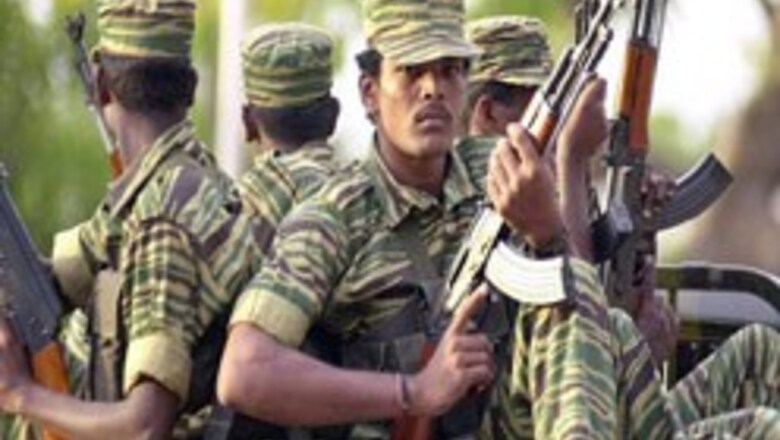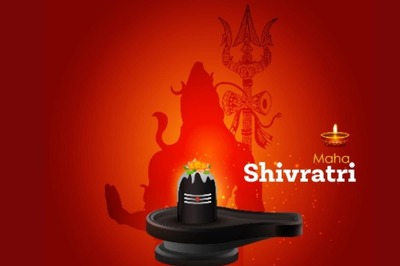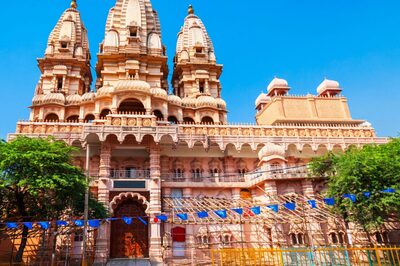
views
Kilinochchi, Sri Lanka: Day and night, warplanes roar over the LTTE-held town of Kilinochchi as the steady thump of artillery echoes from afar – a preview, many fear, of a military showdown in Sri Lanka that could leave thousands dead.
''All we hear is war,'' says Tavakumar, a 43-year-old rebel who only uses one name, patrolling a road a few miles from the front. ''I'm ready to fight.''
Five years after a cease-fire brought a measure of relief to Sri Lanka, a ferocious ethnic war is again raging between the government dominated by the country's predominantly Buddhist Sinhalese majority and the Liberation Tigers of Tamil Eelam (LTTE) rebels seeking a homeland for the largely Hindu Tamil minority.
The signs of a deepening conflict are everywhere: soldiers in full battle gear patrolling Colombo, the increasingly fortified capital; sandbagged bunkers and trenches going up all over the rebel-held north.
Both sides claim to be observing the truce, which remains officially in place. But clearly it has left neither side satisfied, and now it has completely collapsed.
The LTTE is mounting renewed attacks, including a bus bombing last June that killed 64 people, and Sri Lankan forces are pushing farther into rebel territory, with officials openly saying they aim to militarily crush their enemy.
''We want to destroy them, the Tiger bases, all these things,'' Defense Secretary Gotabhaya Rajapakse said. Rajapakse, brother of President Mahinda Rajapakse, survived a Tamil suicide bombing of his motorcade in December.
In Kilinochchi, the main rebel-held city, the cease-fire seemed a distant notion as a pair of warplanes dropped flares to light up a LTTE mortar position in the jungles beyond town. Farmers and insurgents scrambled into dank, makeshift bomb shelters as the jets dropped their bombs, obliterating the mortar position.
Nineteen years of suicide bombings, jungle clashes, torture and village massacres, from 1983 until the truce in 2002, took an estimated 65,000 lives on this West Virginia-sized island of 20 million people off India's southern tip.
Since August, about 3,000 more have been killed and 160,000 displaced, most in eastern Sri Lanka where the government has plowed through relatively lightly defended LTTE territory.
Next up, officials say, is the LTTE's heavily fortified northern heartland, a would-be Tamil state of about 500,000 people with courts, traffic cops, a forestry department and a legal code that bans adultery and pornography.
PAGE_BREAK
It's territory the rebels say they'll defend with everything they've got.
''The fighting in the north is going to be more intense and the (LTTE) probably won't withdraw,'' as they did in the east, said Jehan Perera of Sri Lanka's National Peace Council, a think tank. ''Battlefield losses will be heavier.''
There's also growing concern about the rise in human rights violations. The rebels and government-allied militias are both alleged to have abducted – and in some cases killed – hundreds of civilians, and there are well-documented cases of top government officials threatening critics of the war, especially journalists.
The roots of the conflict stretch back to the years after independence from Britain in 1948, when the government gave Buddhism a prominent role and declared Sinhala the sole official language.
The result was widespread discrimination against Tamils, until war broke out in 1983.
The 2002 cease-fire negotiated by Norwegian diplomats raised hopes, which were reinforced two years later by a belief that the Indian Ocean tsunami would force the warring sides to work together for national recovery. But by late 2005, sporadic shootings and bombings were back. Most – such as a bus bombing that killed 64 people in June – were blamed on the LTTE, who many believed were trying to force the government to make concessions in negotiations.
If that was their strategy, it backfired spectacularly.
Mahinda Rajapakse had been elected president in late 2005 in part by Sinhalese hard-liners who viewed the cease-fire as a betrayal. In August, he opted for all-out war, while claiming to be honoring the cease-fire and only responding to LTTE provocations.
He is being cheered on by hard-line Buddhist monks who see themselves as guardians of the island's Sinhalese culture, and, increasingly, by many ordinary Sinhalese. A recent poll by Colombo's respected Center for Policy alternatives found nearly 60 per cent of the Sinhalese supported a military solution.
It highlights the changing mood in a country that a few years ago was hoping to ride the coattails of India's economic boom and nurture its own blossoming tourism and garment industries.
But while any glitch in India's rush forward is apt to be felt internationally, Sri Lanka's war rages away from center-stage.
PAGE_BREAK
There are no peacekeepers – just a team of cease-fire monitors from Nordic countries with no powers to intervene. The US and European governments regard the LTTE as terrorists but are pressuring the government to stop attacking LTTE territory, pressure that has largely been ignored. India is loath to repeat its disastrous 1989 military intervention in the war.
The not-an-inch attitude of the government and its growing ranks of supporters is evident at a well-heeled dinner party in Colombo, where Jaya Dayananda, a Sinhalese housewife, tells a guest: ''These Tamils, you must understand, only know how to kill.''
''We tried peace. They didn't want peace,'' she says. ''War is our only solution.''
That war is a day's drive north.
At the last checkpoint in government territory, a post that once bustled with people and commerce, a soldier warns of recent shelling in the area and advises: ''You can get killed up there. We can do nothing.''
On the other side, visitors are welcomed to ''Tamil Eelam,'' made to fill out an immigration form, and are thoroughly searched for guns, porn and booze.
Kilinochchi, the LTTE's de facto capital, is another hour up a bumpy road patrolled by farmers and laborers who have been armed and trained to fight.
The rebels, formally known as The Liberation Tigers of Tamil Eelam, assign minders to accompany visitors almost everywhere. There's little opportunity to speak with ordinary people or venture beyond the crumbling main strip of Kilinochchi, a town of one- and two-story buildings hemmed in by bush and jungle, to see their preparations for war.
The air raids are ''the one thing we're afraid of,'' says a 26-year-old who gave only her nom de guerre, Sita. ''There's nothing we can do against them.''
It's hard to gauge the sentiments of ordinary Tamils, but the government's push against the LTTE appears to be strengthening their support for the rebels.
''It's not that we don't have problems with the LTTE – we do,'' says Father James Pathinathan, a Tamil Roman Catholic priest in nearby Mullativu, another rebel town.
''But if you look at the whole picture, people here know they have more to gain from supporting the LTTE,'' he continued. ''So many Tamils are being killed by the government.''
PAGE_BREAK
Fresh graves of rebels are filling the cemeteries and every able-bodied adult – along with quite a few children, say aid workers – is being trained to fight.
''There's no difference now between the political cadres, the military, the regular people,'' says Maran Rajdurai, a former fighter with a deep bullet scar on his left arm.
These days, he works in the LTTE's development secretariat, but says: ''Everyone will fight if they have to.''
The LTTE is now thought to have more than 10,000 men and women in their cult-like army – a force in which fighters aren't allowed to marry until their mid-20s and carry cyanide capsules to kill themselves if captured.
They bested Sri Lanka's 66,000-strong army in conventional battles and waged guerrilla campaigns before the cease-fire, which has given them an opportunity to dig in and rearm.
The rebels have carried out more than 240 suicide bombings; their victims include a Sri Lankan president and former Indian prime minister Rajiv Gandhi. The bombings have led the United States and European Union to label the rebels as terrorists.
In March they launched their first air strike, using a single-propeller plane to drop bombs on an air force base next to the international airport in Colombo, killing three airmen.
The attack sent shivers through the tourism industry, prompted warnings of a new phase in the war, and clearly boosted Tamil morale at a time when stresses are showing in the rebel enclave.
During the cease-fire, buildings went up, banks opened and markets filled with biscuits and soft drinks shipped in from the south.
Nowadays fuel is scarce, power supplies are virtually nonexistent, and even Coca-Cola is hard to come by, jobs even harder.
''Living like this, it's very difficult,'' said a man who gives his name only as Francis.
The 59-year-old, wearing only a soiled cloth around his waist, makes about a dollar a day carrying loads for other people. ''It's not enough,'' he says.
Nonetheless, in a rare conversation with no minder listening, Francis says he'll settle for no less than a LTTE victory.
''We are asking for our freedom from the Sinhalese people,'' he says. ''We should live apart.''


















Comments
0 comment